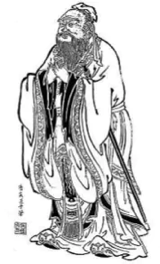
The god P’an Ku

K’ Ung Fu-Tzu, (Confucius)
According to legend, when the world began the god P’an Ku created Yin and Yang out of chaos. When he had created the World his body was assimilated into it; his bones became the mountains, his muscle became the earth, his veins became the rivers, his breath the wind, his sweat the rain and his four limbs became the four pillars which hold up the four corners of the world.
From the earliest times Chinese people developed a theoretical view of their relationship with nature which was based on the dynamic interplay between Yin and Yang and the concept of Tao.
“Since the entire Universe followed one immutable course which became manifest through the change of night to day, through the recurrence of the seasons, through growth and decay man, in his utter dependence upon the Universe, could not do better than follow a way which was conceived after that of nature.
The only manner in which man could attain the right Way, the Tao, was by emulating the course of the Universe and completely adjust to it." (Veith 1966)
This view of the world owes much to the teaching of K’ Ung Fu-Tzu, Confucius, which dominated philosophical, political, social and hence medical thought from the beginning of the Han dynasty in 206 BC until the fall of the Qing dynasty in 1911 AD.
The political and social stability of the Han dynasty, which lasted for four hundred years and coincided with the Roman Empire, relied largely on the influence of the teaching of Confucius on the ruling elite.
Early Confucianism was a philosophy of social order, each member of society had a duty of respect to his elders, his ancestors and his Emperor.
Confucius believed that the key to good government lay in the roe of the Emperor who had the ‘Mandate from Heaven’.
As long as the Emperor was virtuous, behaved honourably and performed the rituals and sacrifices of his office, Heaven would reward the State with good harvests, good weather, good fortune in war and prosperity. Just as the movement of the Universe affected the individual, it was believed that each individual’s actions affected the Universe.
These ideas were reflected by the unknown authors of the collection of medical writings which were compiled into one of the seminal works on Chinese medicine, the Nei Jing (Yellow Emperor Classic of Internal Medicine) during the Later Han period (25- 221 AD) The Nei Jing builds its theoretical framework around Yin Yang and the Five Phases and it was believed that the ' health' of the individual, the ‘health’ of the State and the ‘health' of the Universe were harmonics of each other.
This was thought to be the earliest text that mentioned channel theory, until the discovery in 1973 of eleven medical texts written on silk in Ma Wang Dui Tomb Three, in the Hunan province.
The burial is dated 168BC, but the manuscripts appear to have been written before the end of the third century BC.
The theoretical foundation of these works sees disease being transmitted by ghosts, demons and malevolent spirits, which is in sharp contrast to the theories of the Nei Jing.
Therapy included shamanistic rituals, incantations, spells and herbal prescriptions. Ideas concerning the nature of the Universe and disease changed most radically during the period from about the beginning of the Warring States Period until the Han dynasty.
Shamanism was a perfectly respectable occupation until the first century AD, when it was decided that practitioners, or members of shamanic families, would be forbidden from holding public office.
Confucian orthodoxy never ceased to acknowledge these practices but did tend to look down upon them. The synthesis of Confucian and Taoist ideas saw an important shift in attitudes towards the nature of disease.
From being transmitted by external malevolent agents, the idea that disease resulted from internal disharmony developed to the extent that the Shen Nung P’en Cao, (Classic of the Materia Medica), first compiled no earlier than the first century AD, contains no reference to supernatural causes of disease at all. Early beliefs that disease was carried by either demons or the Wind, did form the idea of a life giving power moving through the body, which came to be known as Qi.
The Han dynasty (206 BC-221 AD) was the classical period of Chinese medicine; the great masters of the time were Chang Chung Ching and Hua To. Chang Chung Ching (born c.158-166) was known as the Chinese Hippocrates.
His major work The Shang Han Lun (Treatise on Cold Induced Disorders) is every bit as important as the Nei Ching. Hua To (born c.136-141) was the outstanding surgeon of the epoch and is renown for his use of anaesthetics.
He is also famous for developing the Five Animal Exercises; the tiger, the stag, the bear, the monkey and the crane, which have come down to us in modern times in the form of Tai Chi Chuan.
During the last century of the Han period the Nan Jing (Classic of difficult issues), which reevaluated sections of the Nei Jing was compiled. In the Nan Jing the Eight Extra Meridians are first mentioned and pulse taking from the radial artery was established.
The period of chaos which followed the collapse of the Han dynasty in 211AD, saw the first appearance of Buddhism as a religious force in China. In 311 AD the Emperor was forced to leave the imperial capital Luoyang and move to Nanjing.
Confucian scholars found their beliefs no longer appropriate in a society deprived of its stability.
The ideas of Taoism with its practices for achieving immortality and longevity, and the rise of Buddhism with its belief that everything material is an illusion and that Nirvana or enlightenment can be achieved by retreating from the world into a life of meditation and contemplation offered better solace in an uncertain world.
This period saw the population fall from 28 million to around half that figure between 200 AD and 280 AD

The yellow emperor



